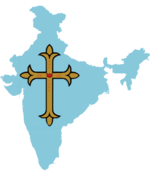Malankara Syriac Knanaya Archdiocese
Thank you for being part of the Bharatpedia family! 0% transparency: ₹0 raised out of ₹100,000 (0 supporter) |
Archdiocese of Malankara Syrian Knanaya Community | |
|---|---|
| Location | |
| Headquarters | St. Aphrem Seminary Chingavanam |
| Information | |
| First holder | Severios Geevarghese[1] |
| Formation | 1910 |
| Denomination | Syriac Orthodox Church |
| Rite | West Syriac Rite |
| Cathedral | St.Thomas Valiyapally, Ranni |
| Co-cathedral | St. Mary's Valiyapally, Kallissery |
| Patron saint | Thomas of Cana |
| Current leadership | |
| Patriarch | Ignatius Aphrem II Patriarch of Antioch |
| Archbishop | Severios Kuriakose |
| Auxiliary Bishops | Gregorios Kuriakose, Ivanios Kuriakose, Silvanos Ayub |
| Website | |
| knanayaarchdiocese.com | |
Malankara Syriac Knanaya Community are part of the larger Knanaya community who are descendants of an endogamous ethnic migrant group of Syriac-Jewish Christians who arrived and settled in Kerala in the 4th or 8th century.[2][3][4]
In the year 345 according to the Malayalam calendar (Kollavarsham), Knai Thoma, a merchant, and 72 families from Edessa (or modern Urfa) immigrated to Malankara (present-day Kerala) and established a community there. Among the group were priests, deacons and a bishop, Uraha Mar Ouseph (Bishop Joseph of Uraha/Urfa). Knai Thoma and his people were welcomed by Cheraman Perumal, the Chera Emperor of Kerala, and were given permission to settle down in Kodungalloor.
After the Coonen Cross Revolt. (Oath of the Bent Cross)a part of the Knanaya Community joined Archdeacon Thomas. They later accepted West Syriac liturgical traditions brought to Malankara by Mor Gregorios Abdal Jaleel of Jerusalem. This group later came under the Patriarch of Antioch. Today they form part of the Knanaya Archdiocese of the Jacobite Syrian Christian Church.
List of Knanaya Syrian Church[edit]
The Knanaya Syrians are Jewish migrants who believed in Syriac Orthodox Church primacy. They're occupied on Pathanamthitta and Kottayam of Kerala and abroad, more than 200 churches.
India[edit]
- Kallissery St. Mary's Church
- Chingavanam St. Johns Church
- Chingavanam St. Johns Puthen Pally
- Kottayam St. Marys Valiya Pally
- Ramamangalam St. Jacob's Valiyapally
- Vakathanam St. Simons Church
North America[edit]
- St. Peter's church, Yonkers, New York
- St. Johns Church, Houston, Texas
- St. James Church, Houston, Texas
- St. Thomas Church, Irving, Texas
- St. Johns Church, Clifton, New Jersey
- St. Marys Church, Philadelphia
- St. Thomas Church, Edmonton, Canada
- St. Ignatius Church, Toronto, Canada
Gulf[edit]
- St. Peter's Church, Kuwait
See also[edit]
References[edit]
- ↑ "Valiyapally". www.valiyapallyranni.com.
- ↑ "Knanaya Samudayam". knanayaarchdiocese.com.
- ↑ "Syriac Orthodox (Jacobite) Churches in India". www.syriacchristianity.info.
- ↑ Williams, Raymond Brady; Brady, Williams Raymond. Christian Pluralism in the United States: The Indian Immigrant Experience. Cambridge University Press. ISBN 978-0-521-57016-9.

